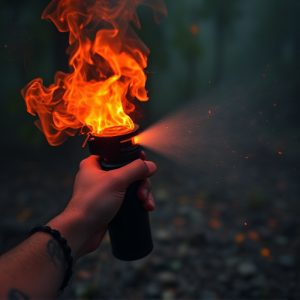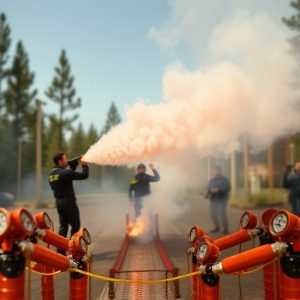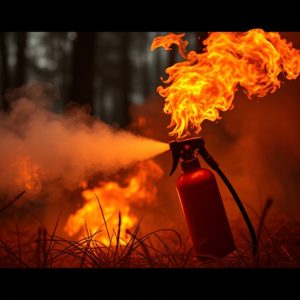Balancing Defense and Ecology: The Role of Wildfire Pepper Spray in Law Enforcement and Fire Prevention
Wildfire pepper spray is an indispensable non-lethal tool for law enforcement, effective in managin…….
Wildfire pepper spray is an indispensable non-lethal tool for law enforcement, effective in managing civil unrest and personal defense scenarios. Its high concentration of oleoresin capsicin causes a swift inflammatory response, resulting in immediate effects like eye swelling, severe pain, coughing, and breathlessness within a 10-foot radius. Enhancements have improved its dispersion against wind and environmental factors, ensuring consistent effectiveness. The effects are both immediate and reversible with medical aid, balancing crowd control with respect for human rights. RCMP-grade Wildfire pepper spray is specifically designed for law enforcement, offering a powerful irritant effect against assailants, with a long-lasting impact of 30 to 45 minutes. It's capable of penetrating through clothing and delivering an ultra-fine mist up to 18 feet away, ensuring officer safety. Training for officers using Wildfire pepper spray is comprehensive, focusing on safe and effective deployment, range estimation, and the use of force levels, with an emphasis on minimizing risks to subjects and bystanders. In addition to its use in civil unrest situations, Wildfire pepper spray also plays a critical role in deterring individuals during wildfires, enhancing containment strategies and protecting sensitive areas, infrastructure, and ecosystems from the ignition sources that can escalate fire spread. Agencies using Wildfire pepper spray must adhere to legal statutes and ethical standards, ensuring appropriate deployment and respect for human rights and dignity in all operations. Transparency and ethical considerations are paramount in maintaining community trust and preserving the integrity of law enforcement practices.
Exploring the multifaceted applications of wildfire pepper spray, this article delves into its pivotal role for law enforcement and surveillance teams. From its potent formulation to the precise training protocols required for its use, we examine the science, strategy, and legal implications. As a critical tool in both public safety and fire management, understanding the intricacies of wildfire pepper spray is paramount for its effective deployment and ethical application. Join us as we navigate the complexities surrounding this indispensable resource in modern security and environmental protection measures.
Understanding Wildfire Pepper Spray: A Comprehensive Overview
Wildfire pepper spray stands as a critical tool for law enforcement agencies in managing a variety of situations, particularly those involving civil unrest or personal defense against aggressive individuals. This advanced form of pepper spray is designed with a high concentration of oleoresin capsicin, delivering an intense and debilitating inflammatory response upon contact with mucous membranes. The effects are swift and temporary, deterring potential threats by causing eye swelling, intense pain, coughing, and shortness of breath. This non-lethal weapon is engineered to be highly effective at creating a deterrent barrier between law enforcement officers and subjects who pose a risk. Its potency is such that it can incapacitate multiple individuals simultaneously within a 10-foot range, making it an invaluable asset for maintaining public safety during volatile scenarios.
Moreover, the development of wildfire pepper spray has incorporated feedback from field operatives to refine its deployment and efficacy. The spray’s precise dispersion minimizes drift and maximizes control in open or confined spaces. It is also formulated to resist wind and environmental factors that could otherwise compromise its effectiveness. The longevity of its effects, coupled with the ease of use, positions wildfire pepper spray as a preferred option for law enforcement over traditional forms of pepper spray. Its impact is not only immediate but also reversible, with medical intervention available to alleviate symptoms should the need arise, thus maintaining the integrity of both human rights and public order.
The Chemistry Behind Wildfire Pepper Spray and Its Effectiveness for Law Enforcement
RCMP-grade Wildfire pepper spray is a non-lethal self-defense tool that law enforcement officers often employ. Its active ingredient, OC (Oleoresin Capsicum), is derived from natural chili peppers and formulated to create an intense irritant upon contact with the eyes, skin, or respiratory system of an assailant. The chemical compound in the spray causes a rapid influx of neurotransmitters in the sensory neurons, leading to burning sensation, intense pain, and temporary blindness. This potent reaction incapacitates the target by disrupting their ability to see, breathe, or continue aggressive behavior. The effects are typically short-lived, lasting from 30 to 45 minutes, making it a highly effective tool for law enforcement to manage confrontations and protect both officers and the public without resorting to lethal force.
The formulation of Wildfire pepper spray is meticulously designed to maximize its defensive capabilities while minimizing the risk of harm. It is specifically engineered to penetrate through clothing, effectively incapacitating individuals who might otherwise be protected by their attire. The dispersal pattern is also crucial; it is crafted to cover a wide area with an ultra-fine mist that can reach up to 18 feet, ensuring safety for officers at a distance. Additionally, the spray is calibrated to deliver the active ingredient in precise amounts, which enhances its effectiveness and reduces any unnecessary exposure to the chemical. The high concentration of OC in Wildfire pepper spray makes it one of the most potent non-lethal defense sprays available to law enforcement personnel, providing them with a reliable tool for crowd control, self-defense, and apprehension of suspects.
Training and Protocols for Law Enforcement Using Wildfire Pepper Spray
Law enforcement agencies have integrated Wildfire pepper spray into their toolkits, recognizing its potent non-lethal capabilities in various scenarios, including crowd management and individual apprehension. Proper training is paramount for officers to effectively and safely deploy Wildfire pepper spray. Comprehensive protocols ensure that personnel are well-versed in the correct techniques for aiming, range estimation, and the appropriate use of force levels. These protocols are designed to minimize the risk of accidental harm to both the subject and bystanders. Training sessions cover both classroom instruction and hands-on practice with the spray, emphasizing situational awareness, wind conditions, and personal protection equipment usage. Officers learn to assess each situation’s dynamics and respond proportionately with the aim of de-escalating conflicts without resorting to more severe measures. The mastery of these skills is critical in upholding public safety while effectively managing incidents involving volatile or combative individuals.
The effectiveness of Wildfire pepper spray in law enforcement operations is contingent upon strict adherence to established protocols and continuous training. These protocols are regularly reviewed and updated to reflect best practices and evolving situational demands. The training program includes not only the physical handling of the spray but also decision-making exercises that challenge officers to consider various scenarios where its use may be necessary. This rigorous approach to training ensures that law enforcement personnel can confidently employ Wildfire pepper spray as part of their duty to protect and serve, with a clear understanding of its impact and the legal implications of its use. By maintaining high standards in training and adhering to strict protocols, agencies can ensure that officers are prepared to handle situations where the deployment of Wildfire pepper spray is both justified and effective.
Evaluating the Impact of Wildfire Pepper Spray on Wildfire Prevention and Control Efforts
Wildfire pepper spray has emerged as a valuable tool in the arsenal of law enforcement agencies combating wildfires. Its effectiveness lies in its ability to deter individuals who may intentionally start fires, either through arson or negligence. When deployed strategically, this non-lethal agent can significantly reduce the incidence of human-induced ignitions by creating a defensive perimeter that deters potential fire starters from approaching too closely to areas at risk. This proactive measure allows for more effective containment and control of wildfires by protecting critical infrastructure and natural habitats.
Moreover, the impact of wildfire pepper spray extends beyond just deterring individuals. It serves as a complementary method to traditional fire suppression techniques, enabling law enforcement to manage the human element in wildfire prevention without compromising the environment or public safety. The use of this spray can be a critical component in a multi-faceted approach that includes surveillance, rapid response, and environmental measures. By deterring arson and reducing the number of fires started by accident, wildfire pepper spray plays a pivotal role in preserving ecosystems and mitigating the damage caused by wildfires, thus enhancing overall wildfire prevention and control efforts.
Legal Considerations and Ethical Use of Wildfire Pepper Spray by Surveillance Teams
Law enforcement teams utilizing Wildfire pepper spray within surveillance operations must navigate a complex array of legal considerations and ethical implications. Legislation governing the use of pepper sprays can vary significantly by jurisdiction, necessitating a thorough understanding of local laws. These laws dictate not only the permissible scenarios for deploying the spray but also the training requirements for personnel authorized to use it. The potency of Wildfire’s formulation mandates strict protocols to ensure its application is both judicious and proportionate to the threat at hand, preventing unnecessary exposure to individuals who may be adversely affected by the spray.
Ethical considerations extend beyond mere legal compliance. Surveillance teams must weigh the immediate tactical benefits of using Wildfire pepper spray against the long-term implications for public trust and confidence in law enforcement practices. The ethical use of such a potent irritant requires clear justifications, documented with appropriate records, to demonstrate that the risk posed by the target subject outweighs the potential harm caused by the pepper spray. Transparency in these decisions is crucial for maintaining community relations and upholding the integrity of surveillance operations. It is imperative that any deployment of Wildfire pepper spray is conducted with the highest regard for human rights, dignity, and safety.


